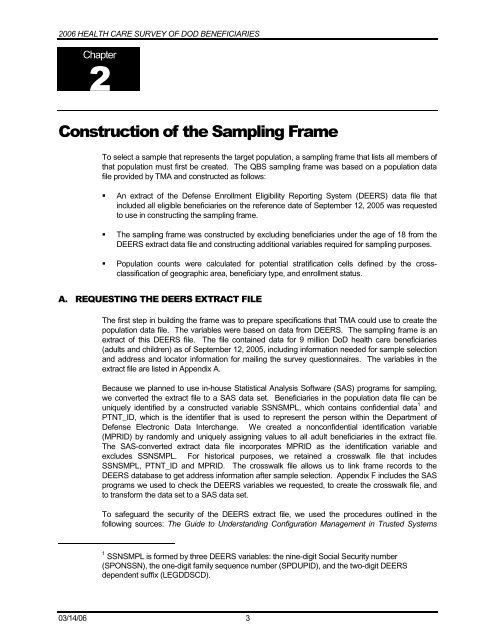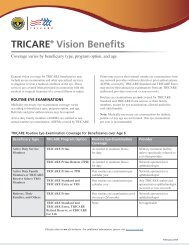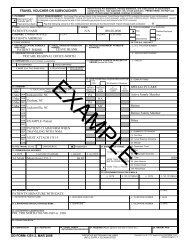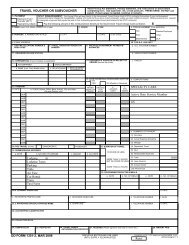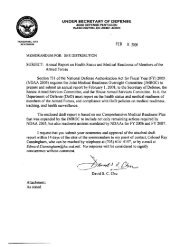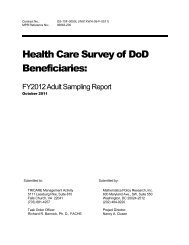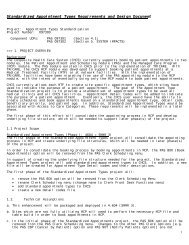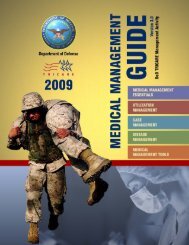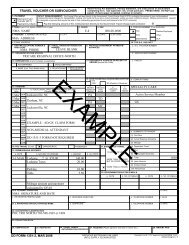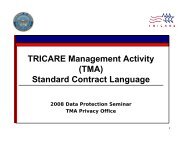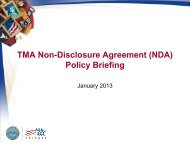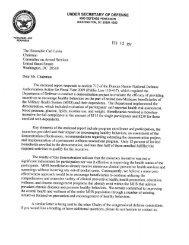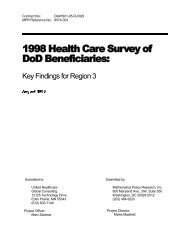2006 HCSDB Adult Sampling Report - Tricare
2006 HCSDB Adult Sampling Report - Tricare
2006 HCSDB Adult Sampling Report - Tricare
- No tags were found...
Create successful ePaper yourself
Turn your PDF publications into a flip-book with our unique Google optimized e-Paper software.
<strong>2006</strong> HEALTH CARE SURVEY OF DOD BENEFICIARIESChapter&RQVWUXFWLRQRIWKH6DPSOLQJ)UDPHTo select a sample that represents the target population, a sampling frame that lists all members ofthat population must first be created. The QBS sampling frame was based on a population datafile provided by TMA and constructed as follows:ƒ An extract of the Defense Enrollment Eligibility <strong>Report</strong>ing System (DEERS) data file thatincluded all eligible beneficiaries on the reference date of September 12, 2005 was requestedto use in constructing the sampling frame.ƒ The sampling frame was constructed by excluding beneficiaries under the age of 18 from theDEERS extract data file and constructing additional variables required for sampling purposes.ƒ Population counts were calculated for potential stratification cells defined by the crossclassificationof geographic area, beneficiary type, and enrollment status.$ 5(48(67,1*7+('((56(;75$&7),/(The first step in building the frame was to prepare specifications that TMA could use to create thepopulation data file. The variables were based on data from DEERS. The sampling frame is anextract of this DEERS file. The file contained data for 9 million DoD health care beneficiaries(adults and children) as of September 12, 2005, including information needed for sample selectionand address and locator information for mailing the survey questionnaires. The variables in theextract file are listed in Appendix A.Because we planned to use in-house Statistical Analysis Software (SAS) programs for sampling,we converted the extract file to a SAS data set. Beneficiaries in the population data file can beuniquely identified by a constructed variable SSNSMPL, which contains confidential data 1 andPTNT_ID, which is the identifier that is used to represent the person within the Department ofDefense Electronic Data Interchange. We created a nonconfidential identification variable(MPRID) by randomly and uniquely assigning values to all adult beneficiaries in the extract file.The SAS-converted extract data file incorporates MPRID as the identification variable andexcludes SSNSMPL. For historical purposes, we retained a crosswalk file that includesSSNSMPL, PTNT_ID and MPRID. The crosswalk file allows us to link frame records to theDEERS database to get address information after sample selection. Appendix F includes the SASprograms we used to check the DEERS variables we requested, to create the crosswalk file, andto transform the data set to a SAS data set.To safeguard the security of the DEERS extract file, we used the procedures outlined in thefollowing sources: The Guide to Understanding Configuration Management in Trusted Systems1 SSNSMPL is formed by three DEERS variables: the nine-digit Social Security number(SPONSSN), the one-digit family sequence number (SPDUPID), and the two-digit DEERSdependent suffix (LEGDDSCD).03/14/06 3


